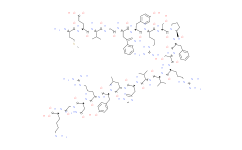| Cas No.: | 149635-73-4 |
| Chemical Name: | Myelin Oligodendrocyte Glycoprotein Peptide (35-55), mouse, rat |
| Synonyms: | L-Lysine,L-methionyl-L-a-glutamyl-L-valylglycyl-L-tryptophyl-L-tyrosyl-L-arginyl-L-seryl-L-prolyl-L-phenylalanyl-L-seryl-L-arginyl-L-valyl-L-valyl-L-histidyl-L-leucyl-L-tyrosyl-L-arginyl-L-asparaginylglycyl-;L-Lysine,L-methionyl-L-a-glutamyl-L-valylglycyl-L-tryptophyl-L-tyrosyl-L-arginyl-L-seryl-L-pro...;L-Lysine,L-methionyl-L-a-glutamyl-L-valylglycyl-L-tryptophyl-L-tyrosyl-L-arginyl-L-seryl-L-prolyl-L-phenylalanyl-L-seryl-L-ar;L-Lysine,L-methionyl-L-a-glutamyl-L-valylglycyl-L-tryptophyl-L-tyrosyl-L-arginyl-L-seryl-L-prolyl-L-phenylalanyl-L-seryl-L-arginyl-L-valyl-L-valyl-L-histidyl-L-leucyl-L-tyrosyl-L-arginyl-L-asparaginyl;MOG (35-55) (rat, mouse);MOG(35-55);Myelin Oligodendrocyte Glycoprotein (35-55) (mouse, rat);MyelinOligodendrocyteGlycoprotein(35-55)(mouse00rat);H-MEVGWYRSPFSRVVHLYRNGK-OH;MET-GLU-VAL-GLY-TRP-TYR-ARG-PRO-PRO-PHE-SER-ARG-VAL-VAL-HIS-LEU-TYR-ARG-ASN-GLY-LYS;MET-GLU-VAL-GLY-TRP-TYR-ARG-SER-PRO-PHE-SER-ARG-VAL-VAL-HIS-LEU-TYR-ARG-ASN-GLY-LYS: MEVGWYRSPFSRVVHLYRNGK;MEVGWYRSPFSRVVHLYRNGK;Myelin Oligodendrocyte Glycoprotein Peptide: 35-55,rat,mouse;MOG (35-55), RAT;MOG (MOUSE, RAT);MOG (35-55), MOUSE, RAT;MOG (RAT, MOUSE, 35-55);MOG PEPTIDE (35-55) (RAT, MOUSE);MYELIN OLIGODENDROCYTE PROTEIN (35-55);Myelin Oligodendrocyte Glycoprotein (35-55);H-MET-GLU-VAL-GLY-TRP-TYR-ARG-SER-PRO-PHE-SER-ARG-VAL-VAL-HIS-LEU-TYR-ARG-ASN-GLY-LYS-OH;(2S)-6-Amino-2-[[2-[[(2S)-4-amino-2-[[(2S)-2-[[(2S)-2-[[(2S)-2-[[(2S)-2-[[(2S)-2-[[(2S)-2-[[(2S)-2-[;Myelin Oligodendrocyte Glycoprotein Peptide (35-55), mouse, rat |
| SMILES: | S(C([H])([H])[H])C([H])([H])C([H])([H])C([H])(C(N([H])C([H])(C([H])([H])C([H])([H])C(=O)O[H])C(N([H])C([H])(C([H])(C([H])([H])[H])C([H])([H])[H])C(N([H])C([H])([H])C(N([H])C([H])(C([H])([H])C1=C([H])N([H])C2=C([H])C([H])=C([H])C([H])=C12)C(N([H])C([H])(C([H])([H])C1C([H])=C([H])C(=C([H])C=1[H])O[H])C(N([H])C([H])(C([H])([H])C([H])([H])C([H])([H])N([H])/C(=N/[H])/N([H])[H])C(N([H])C([H])(C([H])([H])O[H])C(N1C([H])([H])C([H])([H])C([H])([H])C1([H])C(N([H])C([H])(C(N([H])C([H])(C(N([H])C([H])(C(N([H])C([H])(C(N([H])C([H])(C(N([H])C([H])(C(N([H])C([H])(C(N([H])C([H])(C(N([H])C([H])(C(N([H])C([H])(C(N([H])C([H])([H])C(N([H])C([H])(C(=O)O[H])C([H])([H])C([H])([H])C([H])([H])C([H])([H])N([H])[H])=O)=O)C([H])([H])C(N([H])[H])=O)=O)C([H])([H])C([H])([H])C([H])([H])N([H])/C(=N\[H])/N([H])[H])=O)C([H])([H])C1C([H])=C([H])C(=C([H])C=1[H])O[H])=O)C([H])([H])C([H])(C([H])([H])[H])C([H])([H])[H])=O)C([H])([H])C1=C([H])N([H])C([H])=N1)=O)C([H])(C([H])([H])[H])C([H])([H])[H])=O)C([H])(C([H])([H])[H])C([H])([H])[H])=O)C([H])([H])C([H])([H])C([H])([H])N([H])/C(=N\[H])/N([H])[H])=O)C([H])([H])O[H])=O)C([H])([H])C1C([H])=C([H])C([H])=C([H])C=1[H])=O)=O)=O)=O)=O)=O)=O)=O)=O)N([H])[H] |
| Formula: | C118H177N35O29S |
| M.Wt: | 2581.9501 |
| Purity: | >98% |
| Sotrage: | 2 years -20°C Powder, 2 weeks 4°C in DMSO, 6 months -80°C in DMSO |
| Description: | Myelin Oligodendrocyte Glycoprotein Peptide (35-55), mouse, rat is a minor component of CNS myelin. Myelin Oligodendrocyte Glycoprotein Peptide (35-55), mouse, rat produces a relapsing-remitting neurological disease with extensive plaque-like demyelination. Myelin Oligodendrocyte Glycoprotein Peptide (35-55), mouse, rat induces strong T and B cell responses and is highly encephalitogenic[1][2][3]. |
| References: | [1]. Ichikawa M, et al. Analysis of the fine B cell specificity during the chronic/relapsing course of a multiple sclerosis-like disease in Lewis rats injected with the encephalitogenic myelin oligodendrocyte glycoprotein peptide 35-55. J Immunol. 1996 Jul 15;157(2):919-26. [2]. Slavin A, et al. Induction of a multiple sclerosis-like disease in mice with an immunodominant epitope of myelin oligodendrocyte glycoprotein. Autoimmunity. 1998;28(2):109-20. [3]. Zhang GX, et al. T cell and antibody responses in remitting-relapsing experimental autoimmune encephalomyelitis in (C57BL/6 x SJL) F1 mice. J Neuroimmunol. 2004 Mar;148(1-2):1-10. |

 To enhance service speed and avoid tariff delays, we've opened a US warehouse. All US orders ship directly from our US facility.
To enhance service speed and avoid tariff delays, we've opened a US warehouse. All US orders ship directly from our US facility.




















